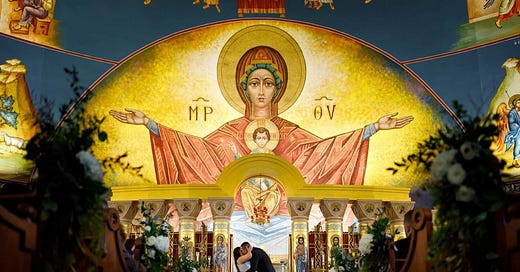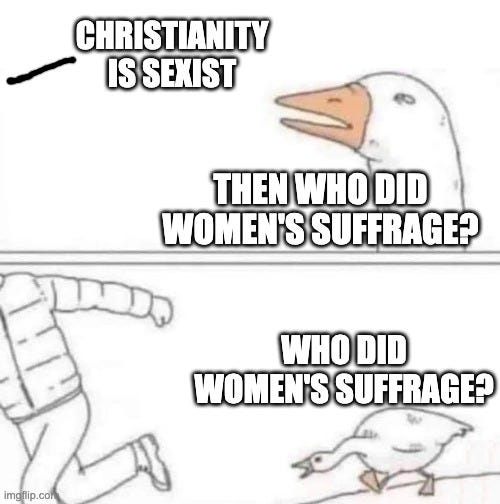I often see this take online lately:
I love Christianity, but as a woman, I just can't get into it because it's too masculine, and doesn’t have any place for the Divine Feminine.
I get where people are coming from, but that’s dead wrong. Christianity, I'd argue, honors the feminine more than almost any other major world religion.
Take a look at this image of the Mother Mary—or the Theotokos—depicted as she often is in Orthodox Christian churches. Notice how the Theotokos is the largest image in the entire space—yes, even larger than the images of Christ.
This isn’t by accident; it’s entirely intentional. Unlike in Western Christianity, Orthodox Christians honor, glorify, and venerate the Theotokos to an exceptionally high degree. She is, without question, the most holy and revered being in all creation. Aside from the Holy Trinity Itself, of course.
Historically, the Orthodox Church has even been accused by the Western Church of “idolizing” the Theotokos because of this profound reverence. Sadly, there’s a major misunderstanding between most Western Christians and how the Orthodox see Mother Mary, and by extension, the Saints and humanity as a whole.
Angels vs. Demons vs. gods
A crucial point to grasp about early Christianity is that, contrary to what many believe today, early Christians did acknowledge the existence of other gods. In his recent book The Religion of the Apostles, Father Stephen DeYoung details the beliefs of early Christians in the first and second centuries. One significant misunderstanding stems from the word "angel," which actually means something closer to "god" in its ancient context.
Early Christians believed that Greek and Roman gods, like Zeus or Poseidon, did exist—but they were seen as demons, not worthy of worship. The idea being that the Most High God, YHWH, assigned every divine being an 'office' or a piece of the Creation to minister.
So Christians didn’t deny these beings' existence; rather, they saw them as divine entities rebelling against the Most High God. A demon was simply a little-g god who was rebelling against the office that God charged them with, trying to divert humanity’s worship away from the true Creator and towards itself.
This concept of divinity in the ancient Near East aligns with the Judaic view during the Second Temple period. Over the following centuries, however, the Jewish faith became increasingly monotheistic, mostly to distinguish itself from Christianity.
Back to the Ladies
Now, I’m sure you’re wondering: How does this relate to the Divine Feminine?
One core tenet of Christianity—and something that utterly shocked the ancient world—was Christ’s teaching that not only was he the Son of God, but that this destiny was also extended to all humanity: to follow Him and become “sons of God.” One of the most famous lines from St. Athanasius, an early Church Father, summarizes this:
"The Son of God became man so that man might become God."
Many modern readers interpret this metaphorically, but the ancient Christians took it literally. Christ genuinely intended for the Saints to rule in glory beside him, replacing the ancient gods—or angels and demons, if you prefer. The entire purpose of God’s incarnation as a man was to elevate men and women beyond even the gods themselves.
So, returning to Mother Mary: she is regarded as the most holy human ever to live. She is the first among saints and is explicitly viewed as greater than any god that ever existed. Here’s one of the hundreds of Orthodox hymns that express this:
"More honorable than the Cherubim, and more glorious beyond compare than the Seraphim, without defilement you gave birth to God the Word."
Not only was the Theotokos meant to be seen as a divine being, she also was seen as the chief advisor of God Himself. In ancient Judaic tradition, the Queen Mother was a revered tradition:
The queen mother in Israel had a powerful influence in the kingdom. This power and authority flows from her status as Gebirah (queen mother) and not from her as a person. In Israel the queen mother preceded her son in existence, sometimes she would rule in his stead.
In early Christian belief, then, the Theotokos was considered, effectively, a goddess. Not only that, but due to the cultural significance that the Queen Mother had at the time, she was literally seen as an extension of the Divine Authority that Christ inherited as the Son of God.
Today, the Theotokos is still venerated and glorified more than any other human or divine being in the Orthodox Church. Orthodox prayer books still to this day often capitalize pronouns referring to her, similar to how Christians refer to the Holy Trinity.
So to clarify: Christianity is actually far more reverent to, and glorifying of, femininity than most other religions. Unlike in Buddhism, Hinduism, or many Native American religions, where women are often seen as lesser, Christianity held one woman as the most glorious human to ever live.
It's worth noting here as well, that out of all the thousands of cultures and religions throughout human history, Christianity is the first culture that not only tried to give women an equal voice to men, it also worked to spread that right to women in other cultures.
Now, I understand that throughout Christian history, especially in the West, this reverence has often been lost, and women have suffered great abuse—to the Church’s shame. However, I hope this article helps show that the true teachings of Christ and the beliefs of his earliest followers are often misrepresented in today’s popular discussions about Christianity.
Let us end by asking for intercession from the great Mother of God: Most holy Theotokos, save us.
Υπεραγία Θεοτόκε, σώσον ημάς.








MOST HOLY THEOTOKOS SAVE US!🕯️❤️ ⛪ ☦️ 📿 🔥